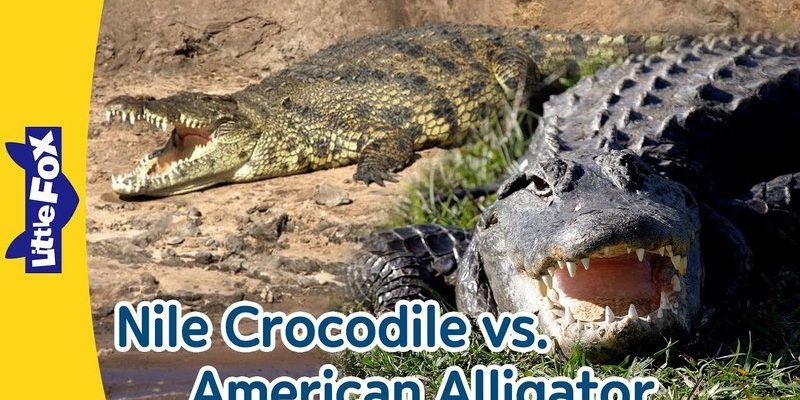![American Alligator Vs. [Similar Species] - How They Compare](https://gudri.com/wp-content/uploads/2025/06/American_Alligator_Vs___Similar_Species____How_They_Compare_image_0.jpg)
So, why are people often confused between the two? Well, they share a common habitat and some physical traits that can make distinguishing them a bit tricky. Imagine trying to tell your friends apart at a crowded party—it’s not always easy! Let’s dive into how these fascinating reptiles compare, looking at everything from physical characteristics to behavior.
Physical Characteristics
One of the first things you might notice when spotting an American alligator is its broad, U-shaped snout, which sets it apart from its crocodile counterpart. Crocodiles have a more pointed, V-shaped snout that looks like it could slice through the water with ease. This snout shape isn’t just for show; it helps them adapt to their diets. Alligators primarily feed on fish and smaller mammals, while crocodiles can handle larger prey thanks to their stronger jaws.
In terms of size, American alligators can grow quite large—typically reaching lengths of 10 to 15 feet. However, some can even surpass 19 feet! Crocodiles, particularly the saltwater variety, can grow even larger, sometimes exceeding 23 feet. That makes them the biggest reptiles on the planet.
Color also plays a role in distinguishing these two. Alligators are usually darker, often a deep olive or blackish color, while crocodiles have lighter, olive-brown shades with a bumpy texture. This coloration is crucial for their camouflage in different environments.
Habitat Preference
Now, let’s talk about where these creatures live. The American alligator primarily resides in freshwater environments like swamps, rivers, and lakes, mainly in the southeastern United States. They have a preference for warm climates, which is why you’ll often see them basking in the sun on the banks of a river.
Crocodiles, on the other hand, are more adaptable. They can thrive in both saltwater and freshwater habitats. You’ll often find them in estuaries, mangrove swamps, and even open oceans. This versatility allows crocodiles to cover a wider range of environments than alligators.
Knowing their habitat is essential for understanding their behavior. Alligators tend to be more territorial and prefer staying close to their home turf, while crocodiles are more migratory, moving between different bodies of water depending on the season.
Behavior and Temperament
When it comes to personality, alligators generally have a reputation for being more laid-back, especially compared to crocodiles. You might not need to worry as much about an alligator jumping out of the water at you. They can be curious but tend to retreat when they sense humans nearby.
Crocodiles, conversely, are often considered more aggressive. They exhibit territorial behavior and are known to defend their space fiercely. This attitude can be traced back to their need to assert dominance over a broader range of habitats, especially where food sources might compete. It’s a little like the difference between a friendly dog and a protective guard dog!
Diet and Hunting Techniques
Next up is their dietary habits. Both alligators and crocodiles are carnivorous, but they employ different tactics when hunting. Alligators primarily ambush their prey, using their powerful jaws and ability to remain hidden in the water. Their method is more about stealth, waiting until the perfect moment to strike.
Crocodiles tend to be more opportunistic and varied in their hunting techniques. They can be ambush predators, but they’re also known to chase down food, especially if they need a bigger meal. You might picture a crocodile waiting patiently like an alligator one moment, and then dashing after a fish the next. Their adaptability makes them quite successful hunters.
Both reptiles have sharp teeth suited for their diets, but alligators have slightly broader teeth for crushing prey, while crocodiles possess sharper teeth for tearing. This is a neat example of how their diets shape their physical traits!
Reproduction and Lifespan
When it comes to reproduction, both species are quite fascinating. The American alligator typically breeds in the spring, building nests out of vegetation near the water. The female lays around 20 to 50 eggs but can become fiercely protective of her young once they hatch.
Crocodiles exhibit similar nesting behaviors, but there’s a twist—some species even lay eggs in saltier environments. The eggs are usually buried in sand or mud, and the temperature can influence the sex of the hatchlings. Warmer temperatures tend to create males, while cooler ones often yield females. Isn’t nature intriguing?
As for lifespan, both reptiles can live a long time, often reaching 35-50 years in the wild. However, with proper care in captivity, they can live up to 80 years or more. Imagine the stories they could tell!
Conservation Status
Lastly, let’s touch on conservation. The American alligator was once endangered due to over-hunting and habitat loss. Thankfully, conservation efforts have helped their population bounce back significantly. They are currently classified as “Least Concern” on the IUCN Red List.
Crocodiles, however, face different challenges depending on the species. Some, like the Siamese crocodile, are critically endangered due to habitat destruction and hunting. This highlights the importance of conservation for both groups, ensuring these incredible reptiles continue to thrive for generations to come. We play a vital role in protecting their environments.
So, there you have it! The American alligator and the crocodile each have their unique characteristics and adaptations that help them survive in their respective environments. While they share some similarities, their differences—from habitat preference to behavior—make them fascinating creatures in their own right. Whether you’re intrigued by the alligator’s more relaxed nature or the crocodile’s adaptability, both species offer a glimpse into the incredible diversity of reptilian life. Next time you’re by the water, take a moment to appreciate these amazing reptiles and the roles they play in our ecosystems. Who knows what other interesting facts you might discover about them!

